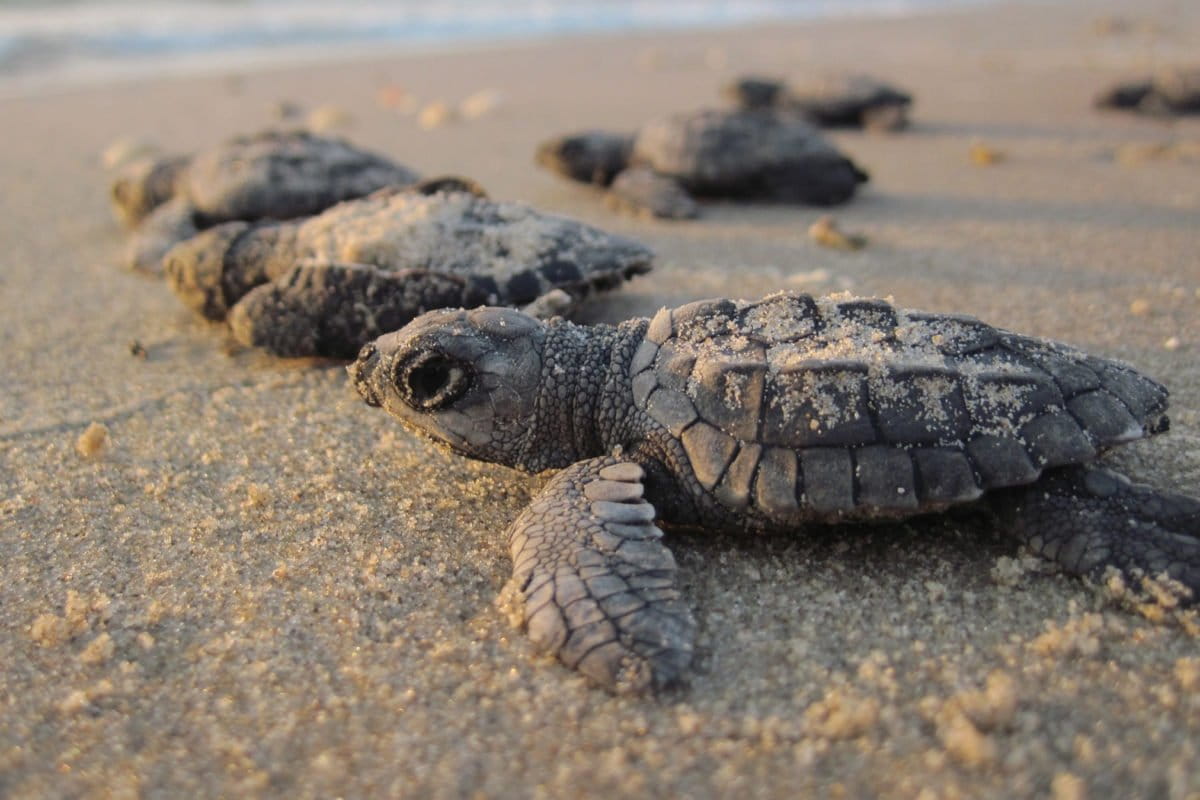- Five percent of all green sea turtles nest on the beaches of tiny Poilão Island, in the Bijagós Archipelago off Guinea-Bissau, leading to some nests being laid on top of each other.
- Sea turtle monitors are rescuing these “doomed clutches” of eggs and relocating them to less crowded beaches.
- In the future, they hope the sea turtle hatchery will provide educational opportunities that strengthen protection of sea turtles.
POILÃO ISLAND, Guinea-Bissau — On a moonlit night in September, hundreds of sea turtles have crawled out of the sea to nest on Poilão Island. A team of turtle monitors from Guinea-Bissau’s National Institute of Biodiversity and Protected Areas (IBAP) have dug a large hole of their own in the sand at one end of their temporary camp a few meters back from the beach.
The monitors are rescuing eggs from “doomed clutches,” where a turtle has laid her clutch on top of an existing one, and there’s a risk that when the deeper-lying babies hatch, they’ll ruin the eggs still incubating in the nest above them.
The monitors’ nest next to the tents is only a temporary resting place. In the morning, they will gingerly place the eggs in a bucket and transfer them to nearby João Vieira Island, where they will be safely buried again and monitored daily by IBAP staff.
João Vieira and Poilão are two of the four islands off the coast of Guinea-Bissau that make up João Vieira-Poilão Marine National Park. They’re part of the 88-island Bijagós Archipelago, the most important sea turtle breeding ground in Africa.

Around 5% of the global green sea turtle (Chelonia mydas) population nests on Poilão, a tiny, 43-hectare (106-acre) island, the southernmost in the archipelago.
Because so many turtles come to these beaches to lay their eggs, nests are sometimes laid on top of each other.
So researchers from IBAP decided to try and rescue some of these threatened nests from both Poilão and nearby Meio Island.
“Since there were a lot of nests that were ruined, we thought it was better not to leave the eggs that are ruined. We thought, what can we do to save these nests?” says Castro Barbosa, head of sea turtle monitoring for IBAP.
At some nesting sites, like those in Cabo Verde, about 500 kilometers (300 miles) northwest of the Bijagós, many clutches are threatened by predators or high tides, so hatcheries are an important conservation tool, according to Rita Patrício, a sea turtle researcher with Lisbon’s Instituto Superior de Psicologia Aplicada and the University of Exeter in the U.K., who has been working with IBAP for more than a decade.
“In the Bijagós, this is not the case, as most clutches are safe from flooding and predation at Poilão. So the hatchery is more like an experiment, and potentially can be used for education purposes, ecotourism, and also eventually the IBAP might start translocations of eggs from Poilão — where there are too many. This could be good in the future, so that the nesting is more broadly distributed.”

In 2019, IBAP set up a pilot hatchery on João Vieira. But the beach they moved the rescued clutches to was later flooded, and none survived. The next year, they moved 20 nests and had a 68% survival rate.
Castro said the hatchery will not only help increase the number of sea turtles that survive, but also hopefully become an educational opportunity for students in the country.
“We started to reflect, how can we teach children about these turtles? There are a lot of people who don’t know anything about turtles.”
To reach the nesting beaches on Poilão, the remotest of the Bijagós Islands, one has to cross the rough, open sea. João Vieira is easier to access, and Castro said IBAP hopes to eventually bring students to see the nesting and hatching process eventually.
He said he hopes that increased education about sea turtles will reinforce the importance of protecting these islands and the turtles that return to these vital nesting grounds.
‘I feel obligated to protect them’: A lifelong love affair with Guinea-Bissau’s turtles
Banner image of green sea turtle hatchlings via Stockvault.
FEEDBACK: Use this form to send a message to the author of this post. If you want to post a public comment, you can do that at the bottom of the page.
